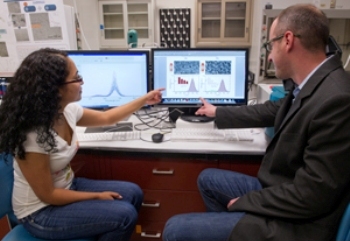Scientists at Syracuse University's College of Arts and Sciences have used nanoscience to discover a new way to harness the natural light generated by fireflies. This discovery resulted in creating a new system which is 20 to 30 folds more efficient than those created in prior experiments.
 Mathew Maye and Rabeka Alam, a chemistry Ph.D. candidate study the BRET data produced by the quantum nanorods.
Mathew Maye and Rabeka Alam, a chemistry Ph.D. candidate study the BRET data produced by the quantum nanorods.
Mathew Maye, assistant professor of chemistry in Syracuse University's College of Arts and Sciences, stated that the firefly light is an excellent example of bioluminescence. Maye, along with Rabeka Alam, a chemistry Ph.D. candidate, have identified a novel technique to leverage biology for nonbiological applications and this was done by controlling the interface between the nonbiological and biological components.
The study, “Designing Quantum Rods for Optimized Energy Transfer with Firefly Luciferase Enzymes” appeared in Nano Letters, a premier journal in the nanoscience field. Professor Bruce Branchini and Danielle Fontaine at Connecticut College have worked together on this research.
The light is produced by fireflies through a chemical reaction occurring between luciferin and the luciferase enzyme. In the lab experiment, this enzyme is bonded to the nanorod's surface, while lluciferin acts as the fuel. The fuel and the enzyme interact together to produce energy, which is transferred to the nanorods, thus causing the nanorods to glow. This process is known as Bioluminescence Resonance Energy Transfer (BRET).
Maye stated that the distance between the enzyme and the nanorod’s surface needs to be reduced in order to enhance the rod's architecture and in turn improve the efficiency of the system. The nanorods consist of an outer shell made of cadmium sulfide and an inner core made of cadmium seleneide. The color of the light is changed by manipulating the rod length and the core size. BRET scale was used to measure the efficiency of the system.
Maye believes that the system could be used in potential technologies for directly converting chemical energy into light.